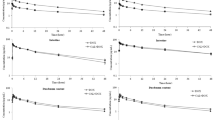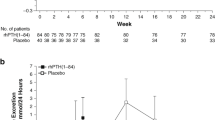Abstract
Purpose
High-dose calcitriol (1,25-dihydroxyvitamin D3) has antineoplastic activity against a range of tumors and potentiates chemotherapeutic agents. In an earlier canine study, the MTD of intravenous (i.v.) calcitriol was 3.75 μg/kg, but polysorbate-associated hypersensitivity reactions were common. Use of commercially available oral calcitriol is limited by the absence of a formulation of suitable strength to allow administration of a reasonable number of caplets. This study evaluated the bioavailability of DN101, a concentrated oral calcitriol formulation specifically developed for anticancer applications.
Methods
An open-label, single-dose, 2-way crossover study was conducted. Dogs randomly received a single 3.75 μg/kg dose of calcitriol either i.v. or oral (as DN101), followed by cisplatin (60 mg/m2). Three weeks later, the alternate form of calcitriol was given prior to another dose of cisplatin. Dogs received antihistamines and corticosteroids prior to both treatments. Food was withheld for 12 h before and after therapy. Serum calcitriol concentrations were measured by radioimmunoassay.
Results
Ten tumor-bearing dogs received both i.v. and oral calcitriol. Six dogs experienced hypersensitivity reactions during i.v. calcitriol. Sequence of calcitriol administration (day-1 vs. day-21) by either i.v. or oral routes had no effect on the major calcitriol pharmacokinetic parameters. Oral calcitriol resulted in significantly lower values for AUC (P = 0.05) and prolonged T 1/2 (P = 0.003) when compared to i.v. Calcitriol oral bioavailability was highly variable among dogs (mean ± SEM, 71 ± 12.6%).
Conclusions
This study demonstrates that a high-dose formulation of calcitriol has a moderate bioavailability in dogs, but inter-individual variability in PK parameters is similar to that observed in people. With this bioavailability, serum concentrations of calcitriol that exhibit antitumor activity in a preclinical murine model were achieved in some dogs. Exploration of methods to minimize variation in calcitriol systemic exposure is warranted.

Similar content being viewed by others
References
(2004) Veterinary co-operative oncology group common terminology criteria for adverse events (VCOG-CTCAE) following chemotherapy or biological antineoplastic therapy in dogs and cats v1.0. Vet Compar Oncol 2:195–213
Beer TM, Javle M, Lam GN, Henner WD, Wong A, Trump DL (2005) Pharmacokinetics and tolerability of a single dose of DN-101, a new formulation of calcitriol, in patients with cancer. Clin Cancer Res 11:7794–7799
Beer TM, Javle MM, Ryan CW, Garzotto M, Lam GN, Wong A, Henner WD, Johnson CS, Trump DL (2007) Phase I study of weekly DN-101, a new formulation of calcitriol, in patients with cancer. Cancer Chemother Pharmacol 59:581–587
Beer TM, Munar M, Henner WD (2001) A phase I trial of pulse calcitriol in patients with refractory malignancies: pulse dosing permits substantial dose escalation. Cancer 91:2431–2439
Beer TM, Myrthue A (2006) Calcitriol in the treatment of prostate cancer. Anticancer Res 26:2647–2651
Blanke CD, Beer TM, Todd K, Mori M, Stone M, Lopez C (2009) Phase II study of calcitriol-enhanced docetaxel in patients with previously untreated metastatic or locally advanced pancreatic cancer. Invest New Drugs 27:374–378
Colburn WA, Gibson DM, Rodriguez LC, Bugge CJ, Blumenthal HP (1985) Effect of meals on the kinetics of etretinate. J Clin Pharmacol 25:583–589
Colburn WA, Gibson DM, Wiens RE, Hanigan JJ (1983) Food increases the bioavailability of isotretinoin. J Clin Pharmacol 23:534–539
Deeb KK, Trump DL, Johnson CS (2007) Vitamin D signalling pathways in cancer: potential for anticancer therapeutics. Nat Rev Cancer 7:684–700
Doose DR, Minn FL, Stellar S, Nayak RK (1992) Effects of meals and meal composition on the bioavailability of fenretinide. J Clin Pharmacol 32:1089–1095
Fernandez E, Borgstrom B (1990) Intestinal absorption of retinol and retinyl palmitate in the rat. Effects of tetrahydrolipstatin. Lipids 25:549–552
Flory AB, Rassnick KM, Balkman CE, Kiselow MA, Autio K, Beaulieu BB, Lewis LD (2008) Oral bioavailability of etoposide after administration of a single dose to tumor-bearing dogs. Am J Vet Res 69:1316–1322
Fukui E, Kurohara H, Kageyu A, Kurosaki Y, Nakayama T, Kimura T (1989) Enhancing effect of medium-chain triglycerides on intestinal absorption of d-alpha-tocopherol acetate from lecithin-dispersed preparations in the rat. J Pharmacobiodyn 12:80–86
Gocek E, Studzinski GP (2009) Vitamin D and differentiation in cancer. Crit Rev Clin Lab Sci 46:190–209
Kahraman M, Sinishtaj S, Dolan PM, Kensler TW, Peleg S, Saha U, Chuang SS, Bernstein G, Korczak B, Posner GH (2004) Potent, selective and low-calcemic inhibitors of CYP24 hydroxylase: 24-sulfoximine analogues of the hormone 1alpha, 25-dihydroxyvitamin D(3). J Med Chem 47:6854–6863
Kararli TT (1995) Comparison of the gastrointestinal anatomy, physiology, and biochemistry of humans and commonly used laboratory animals. Biopharm Drug Dispos 16:351–380
Khoo SM, Edwards GA, Porter CJ, Charman WN (2001) A conscious dog model for assessing the absorption, enterocyte-based metabolism, and intestinal lymphatic transport of halofantrine. J Pharm Sci 90:1599–1607
Korytko PJ, Rodvold KA, Crowell JA, Stacewicz-Sapuntzakis M, Diwadkar-Navsariwala V, Bowen PE, Schalch W, Levine BS (2003) Pharmacokinetics and tissue distribution of orally administered lycopene in male dogs. J Nutr 133:2788–2792
Masini E, Planchenault J, Pezziardi F, Gautier P, Gagnol JP (1985) Histamine-releasing properties of Polysorbate 80 in vitro and in vivo: correlation with its hypotensive action in the dog. Agents Actions 16:470–477
McDowell LR (2000) Vitamin D. In: McDowell LR (ed) Vitamins in animal and human nutrition. Wiley-Blackwell, Hoboken, pp 91–155
McNamara PJ, Jewell RC, Jensen BK, Brindley CJ (1988) Food increases the bioavailability of acitretin. J Clin Pharmacol 28:1051–1055
Muindi JR, Johnson CS, Trump DL, Christy R, Engler KL, Fakih MG (2009) A phase I and pharmacokinetics study of intravenous calcitriol in combination with oral dexamethasone and gefitinib in patients with advanced solid tumors. Cancer Chemother Pharmacol 65:33–40
Muindi JR, Modzelewski RA, Peng Y, Trump DL, Johnson CS (2004) Pharmacokinetics of 1alpha, 25-dihydroxyvitamin D3 in normal mice after systemic exposure to effective and safe antitumor doses. Oncology 66:62–66
Muindi JR, Peng Y, Potter DM, Hershberger PA, Tauch JS, Capozzoli MJ, Egorin MJ, Johnson CS, Trump DL (2002) Pharmacokinetics of high-dose oral calcitriol: results from a phase 1 trial of calcitriol and paclitaxel. Clin Pharmacol Ther 72:648–659
Muindi JR, Potter DM, Peng Y, Johnson CS, Trump DL (2005) Pharmacokinetics of liquid calcitriol formulation in advanced solid tumor patients: comparison with caplet formulation. Cancer Chemother Pharmacol 56:492–496
Porter CJH, Charman WN (1997) Uptake of drugs into the intestinal lymphatics after oral administration. Adv Drug Deliv Rev 25:71–89
Rassnick KM, Muindi JR, Johnson CS, Balkman CE, Ramnath N, Yu WD, Engler KL, Page RL, Trump DL (2008) In vitro and in vivo evaluation of combined calcitriol and cisplatin in dogs with spontaneously occurring tumors. Cancer Chemother Pharmacol 62:881–891
Schuster I, Bernhardt R (2007) Inhibition of cytochromes p450: existing and new promising therapeutic targets. Drug Metab Rev 39:481–499
Schuster I, Egger H, Bikle D, Herzig G, Reddy GS, Stuetz A, Stuetz P, Vorisek G (2001) Selective inhibition of vitamin D hydroxylases in human keratinocytes. Steroids 66:409–422
Smith DC, Johnson CS, Freeman CC, Muindi J, Wilson JW, Trump DL (1999) A phase I trial of calcitriol (1, 25-dihydroxycholecalciferol) in patients with advanced malignancy. Clin Cancer Res 5:1339–1345
Usuki K, Endo M, Osawa M, Kitazume K, Iki S, Urabe A (1996) Pharmacokinetics of all-trans-retinoic acid in Japanese patients with acute promyelocytic leukemia. Int J Hematol 63:19–23
Vertzoni M, Valsami G, Reppas C (2006) Plasma profiles of lycopene after single oral and intravenous administrations in dogs. J Pharm Pharmacol 58:1211–1217
Walter-Sack I, Haefeli WE (2000) Consideration of drug absorption in customizing drug therapy. Ther Umsch 57:557–562
Acknowledgments
This work was supported by grants (NCI and DOD Grants CA67267, CA95045, and PCRP050202) and The Cornell University Hospital for Animals, Cornell University College of Veterinary Medicine. The authors thank Dr. Gerald Fetterly, Associate Director, Pharmacokinetics/Pharmacodynamics, Roswell Park Cancer Institute, for assistance with the pharmacokinetic analysis.
Author information
Authors and Affiliations
Corresponding author
Rights and permissions
About this article
Cite this article
Rassnick, K.M., Muindi, J.R., Johnson, C.S. et al. Oral bioavailability of DN101, a concentrated formulation of calcitriol, in tumor-bearing dogs. Cancer Chemother Pharmacol 67, 165–171 (2011). https://doi.org/10.1007/s00280-010-1304-2
Received:
Accepted:
Published:
Issue Date:
DOI: https://doi.org/10.1007/s00280-010-1304-2




